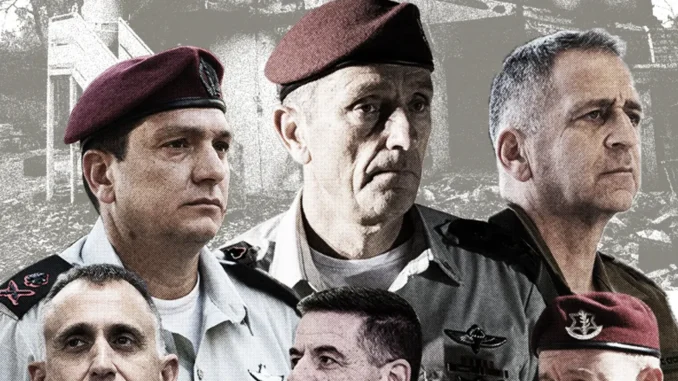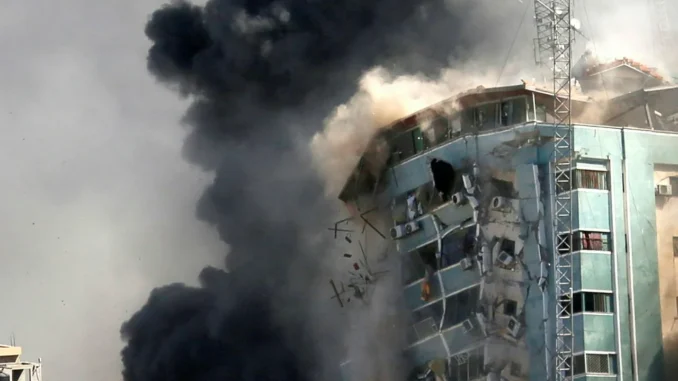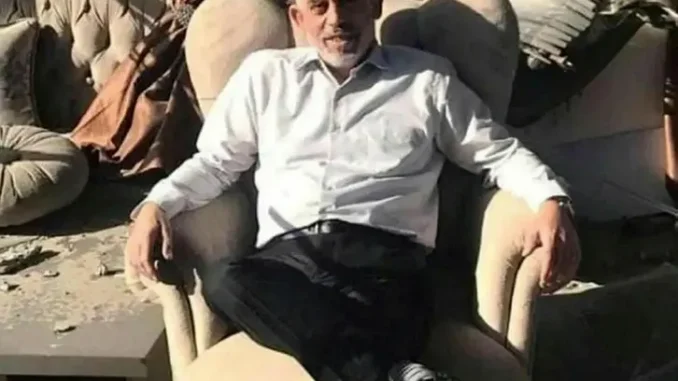Documents and minutes from closed-door meetings reveal the scale of complacency and mistaken preparations by Israeli top defense officials regarding Hamas
An unusual event took place one wintry day on Israel’s border with the Gaza Strip. The top brass were present: from the chief of staff to major-generals. Even Israel’s Defense Minister made sure to take part in the event which was for the most part kept under wraps: the Defense Ministry asked the local media not to report on it before it took place. “This is a reality-altering event…,” the chief of staff said in his speech. “What came before will no longer exist.”
This gathering took place sometime in December 2021, during the inauguration of the underground barrier along the entire Gaza border, at the cost of 3.5 billion shekels ($1.1 billion). The chief of staff was Lt. Gen. Aviv Kochavi, and the project he lauded was planned as “part of the iron wall of our defense doctrine.” Today, it might be seen as a memorial wall for the victims of October 7, a monument to the mistaken doctrine that preceded it.
- Israeli intel detected Israeli SIM cards activated by Hamas hours before Oct 7 assault
- A series of failures proves that Israel’s security concept is obsolete
- Smotrich’s dangerous battle to blame the IDF for October 7
One of the few members of the media who bothered to attend the celebratory occasion was Roi Idan, a resident of Kfar Azza and a Ynet photographer, who was murdered on that Saturday. His wife, Smadar, was also killed, while his 4-year-old daughter, Avigail, was taken hostage. Two other children remained in the house alone, surrounded by horror.
Like the barrier that failed to prevent the attack, the doctrine was constructed over the course of years. Documents and minutes from closed-door meetings that Haaretz obtained in the years before the Hamas attack record the process in detail.
The material indicates excessive self-confidence among the senior command, hesitancy among officers to express a professional opinion contradicting top diplomatic and security policymakers, intentional magnification of military achievements in previous fighting in Gaza, gaps in intelligence concerning Hamas’ increasing strength – and above all, arrogance and contempt for the other side.

Maj. Gen. (res.) Tamir Hayman, head of Military Intelligence 2018-2021, currently Managing Director of the Institute for National Security Studies
One of those who frequently appeared onscreen in those days – moving from one studio panel to the next to analyze and plead – was Maj. Gen. (res.) Tamir Hayman. He now heads the Tel Aviv University-affiliated Institute for National Security Studies and has previously held several positions in the military. His last role was as head of Military Intelligence between 2018 and 2021. In other words, he has the résumé of an expert on Hamas and Gaza. And yet?
Most of the routes Hamas prepared over many years have been damaged and taken away from it … We have succeeded in deciphering the network of tunnels in Gaza.
Maj. Gen. (res.) Tamir Hayman
In a private meeting held at a base in the center of the country during his tenure, Hayman said: “It’s fascinating to see the process that Hamas is undergoing.” He added: “They have a growing commitment to governing and this is creating tensions within the movement – between the desire to fight [on the one hand] and governing and concern for infrastructure [on the other].”
The ceremony marking the completion of the barrier on the Gaza Strip border in 2021. Left to right: Eshkol Regional Council Gadi Yarkon; Alon Schuster, deputy defense minister; Eran Ofir, head of the border barrier project in the Defense Ministry; Defense Ministry director general Amir Eshel; Benny Gantz.Credit: Eliyahu Hershkowitz
“It’s equivalent to denying our air force’s capabilities. Most of the routes Hamas prepared over many years have been damaged and taken away from it … We have succeeded in deciphering the network of tunnels in Gaza. The second we know where one of their commanders is underground, there is the possibility of striking him in an attack.” Put more simply, and still quoting Hayman: “There has been a nearly perfect tactical victory.”

Lt. Gen (res.) Aviv Kochavi, the chief of staff in 2019-2023, currently a private citizen
Like Military Intelligence, Aviv Kochavi, chief of staff between 2019 and 2023, believed Hamas had been sufficiently deterred by Israel and that, practically speaking, both of them were facing a common enemy: Islamic Jihad. “Gaza, to a large extent, depends on [Baha] Abu al-Ata,” said Kochavi in October 2019, referring to the commander of the Northern Brigade of Islamic Jihad.

Lt. Gen. Herzl Halevi, the chief of staff. Commander of the Southern Command in 2018-2021 and deputy chief of staff in 2021-2022
In every sense, including the fact that Hamas didn’t participate in the fighting, Operation Black Belt accelerated Israel’s attempts to come to an arrangement with the terror organization, including the transfer of cash-filled suitcases. In the short term, this was chalked up by leaders as a resounding success.
“Hamas has gone in the direction of an arrangement and calm, and a rift has opened between it and Islamic Jihad that is creating tensions between the organizations,” said Herzl Halevi, head of the Southern Command at the time, in November of 2019. “We aren’t seeing anyone who can take on the governance of the Gaza Strip instead of Hamas. Even though we aren’t happy about this and about the Hamas agenda, it is still a kind of lesser evil.”
And next? “Essentially, we aren’t shooting at Hamas, nor they at us,” said Halevi. He added with a half-smile: “There could be a barrage from Hamas, but it will probably be symbolic, with a wink. We also know how to give a painful wink.”

Maj. Gen. Eliezer Toledano, head of the Strategy Directorate at the General Staff, commander of the Gaza Division in 2018-2021, and head of the Southern Command in 2021-2023
“We landed a heavy blow on Islamic Jihad and we wiped out the organization’s military capabilities,” Maj. Gen. Eliezer Toledano asserted decisively in November of 2019. “In our view,” added the commander of the Gaza Division at the time, “we achieved all our aims, fully and rapidly. We attacked dozens of targets of [Islamic] Jihad terror infrastructure, including their underground [network].”

Maj. Gen. (res.) Amikam Norkin, commander of the air force in 2017-2022, currently a board member at a logistics company
The optimistic discussions about Hamas sometimes reached the point that harm to its members entailed an apology, at least ostensibly. That was the case in August 2020, the period when incendiary balloons were launched into agricultural areas in Israel. Maj. Gen. Amikam Norkin, then commander of the air force, participated in a discussion at the IDF headquarters in Tel Aviv.
Its topic was the military response policy to Hamas security actions targeting Israel. “One target that was attacked is a facility for the production of aerial systems for their drones, which was destroyed by one of our drones,” said the major general, and immediately clarified: “There was no intention to kill Hamas members.”
A building housing media organizations that was bombed by the IDF in May 2021. ‘It’s fascinating to see the process that Hamas is undergoing,’ said Hayman in a closed-door meeting.Credit: Hatem Moussa/AP Photo
After the May 2021 war, known as Operation Guardian of the Walls, Norkin spoke proudly about the IDF’s actions in a discussion at which he was asked to talk about the operation’s achievements. “In this operation, the intensity of the attack was much greater than in previous rounds,” he said.
Unlike in previous fighting, Norkin wanted to express, this time the air force struck “first at the production system, right at the start of the fighting. We took away their capability to produce and advance.” The air force commander added an assessment to the effect that it would take Hamas at least a year to renew its armaments and said: “We are succeeding in bringing Hamas to the right place.”
Maj. Gen. Aharon Haliva.Credit: Moti Milrod
Maj. Gen. Aharon Haliva, head of Military Intelligence, formerly head of the Operations Directorate in 2018-2021
Less than 24 hours before the start of Operation Guardian of the Walls, many members of the General Staff assessed that Hamas threats to launch rockets at Jerusalem on Jerusalem Day were mere saber-rattling. It was meant for Arab ears, some said at the time. They argued that Yahya Sinwar, the Hamas leader in Gaza, knew the significance of rockets on Jerusalem, especially on that day, meant war.”
Benjamin Netanyahu, the prime minister
What preceded Operation Guardian of the Wallsin in no way decreased the excitement at IDF headquarters about its achievements and, of course, the deterrence that would follow. “This is only the beginning. We will strike them with blows they never dreamed of,” said Prime Minister Benjamin Netanyahu at a briefing during the fighting, which took place during the election campaign.
“During the past 24 hours, we attacked targets underground. Hamas thought it could hide there, and it can’t hide there. We are reaching them everywhere, all these people, and we will continue to do so. They attacked us on our day of celebration, they attacked our capital, they launched rockets at our cities, [and] they are paying and will pay a big price for it.”
Hard for them to reconstruct
The IDF and Shin Bet security service didn’t conceal their pride in the achievements of the war. Already in its first days, they issued a statement to the General Staff about the killing of top members of Hamas. “The damage to the highest command level in the production and development of armaments in Hamas, along with the damage to most of their infrastructure is something that will be hard for them to reconstruct,” asserted the joint statement.
The photo of Sinwar distributed by Hamas after Operation Guardian of the Walls. ‘The Israeli strikes did not reach the infrastructures of the factions in Gaza,’ he said .
A week after the end of the operation, things already looked different. Hamas released a photo of Sinwar, smiling and seated in an armchair outside his office in Khan Yunis, which had been bombed. An image of victory. In Israel, officials tried to sell exactly that same picture as positive. However, Sinwar then announced: “We have more than 500 kilometers (310 miles) of tunnels in The Gaza Strip, and the damage is no more than 5 percent. The Israeli strikes did not reach the infrastructure of the factions in Gaza.”
On May 21, 2021, the cease-fire that ended Operation Guardian of the Walls came into effect. Two days later, Chief of Staff Kochavi visited the operations division at the Southern Command intelligence department and said: “We must remain critical towards ourselves [and] remain humble.” No criticism was voiced, and the humility rose to the higher stories of the IDF headquarters building only at 6:29 A.M. on October 7.







But was it arrogant negligence or was it far more nefarious! Either way they need to be investigated, charged then prosecuted. If it’s unmentionable, this probably transcends just the gov and military(still must be held accountable) is part of this global takeover agenda!
Smug, arrogant, superficial, wishful thinkers ; IDF and politicians both left and right ; same Israeli mentality since 1992 when launched the Oslo disaster.
It was Milton Friedman who once said about some left leaning economists “They proceed on the basis of a fiction of their own making.” This is all too often the case today everywhere you look. And people die.
Folly built upon folly, fueled by politically tinted analysis which was tied to well to false conceptions and too little to reality. Those who made these mistakes must go, and be replaced with new leadership which is entirely divorced from their predecessor. The old conception and those who worshiped at its feet can not be allowed to form the foundation of what comes next. The followers of the old conception must be eradicated, root, limb and leaf.